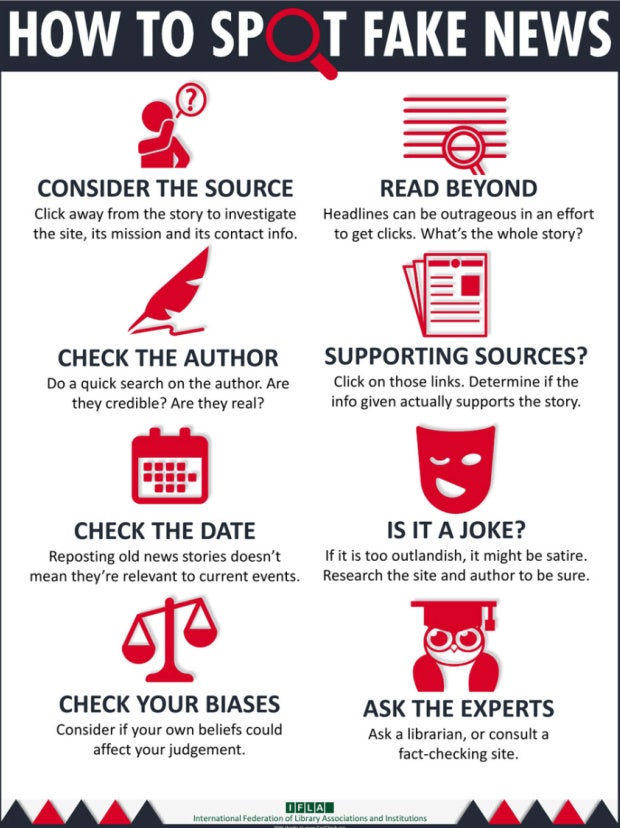What It Means When People Talk About Misinformation Vs. Disinformation
Both are becoming more prevalent, but one is far more damaging.
 tommaso79 / shutterstock
tommaso79 / shutterstock Regardless of what you think about Donald Trump, one thing we can’t deny is his influence on the use of buzzwords in everyday media.
One of his most pervasive phrases is ‘fake news,’ a term he claims to have made up himself (which, ironically, is probably a piece of fake news itself).
While ‘fake news’ may be a catchy way to describe what’s happening in the media, particularly online, it’s nothing new. Instead, it’s a relatable phrase that describes misinformation and disinformation, which have both been around for centuries.
The terms ‘misinformation’ and ‘disinformation’ are often used interchangeably. However, the two vary vastly in meaning.
What is the difference between misinformation vs. disinformation?
According to Dictionary.com, misinformation is “false information that is spread, regardless of whether there is intent to mislead.”
On the other hand, they define disinformation as “deliberately misleading or biased information” or a “manipulated narrative or facts.”
And a third, similar term, malinformation, has been classified by researchers as information that is both false and used with the intent to cause others harm.
Misinformation is generally not malicious.
In fact, the person sharing the information likely believes it’s true.
The term has been around since the 1500s as a combination of “mis,” meaning wrong, and information, and its original use does not give a suggestion for why such information would be spread. This is why misinformation today is not considered to be malicious.
We see misinformation every day, and you’re probably even guilty of spreading it.
For example, if someone asks you the date of a mutual friend’s birthday and you mistakenly give the wrong date, that’s misinformation. While not done maliciously, the mistake can still have unwelcome consequences, such as that friend wishing your other friend a happy birthday on the wrong day.
A larger-scale example is the coronavirus pandemic that led to a ton of misinformation.
As doctors and scientists worked to identify and protect the public from the rapidly spreading and evolving virus, information on the virus changed on a daily basis. This led to the spread of a lot of outdated and inaccurate information.
While this wasn’t done to intentionally mislead the public, the ever-changing information naturally led people to become skeptical of all the things we were being told to do and not to do. The public’s skepticism made it easy for disinformation to then permeate society.
Unlike misinformation, the goal of disinformation is to influence someone based on “facts” that are spun to read a certain way with an intent to deceive.
While misinformation is not spread with an intent to harm, disinformation takes misinformation and purposely uses it to mislead people.
Compared to misinformation, the origin of disinformation is far more recent, with the first use recorded somewhere in the late 1960s.
The major difference between the two terms can be seen in their prefixes, with “mis” meaning wrong and “dis” meaning “anti,” suggesting that disinformation is essentially the opposite of useful information.
Going back to the coronavirus example, skepticism and uncertainty caused a lot of people to seek answers.
The Internet makes it incredibly easy for people to create their own websites and publish bogus stories and studies unchecked, which is what many people did to promote conspiracy theories and prey on those looking for answers to cling to, no matter how far-fetched.
This intentionally manipulated and misleading information is therefore disinformation as opposed to misinformation.
Misinformation and disinformation are rampant on social media.
It was much more difficult to spread individual thoughts and opinions before the days of social media when fringe ideas and conspiracy theories remained mostly underground.
However, social media makes opinions so easily and rapidly shareable. Moreover, literally anyone can not only create a social media account on one of many platforms but also gain hundreds of thousands and even millions of followers to share it with.
No one is right 100% of the time (even if we don’t want to admit it), so it makes sense that misinformation is so prevalent on social media.
When it comes to disinformation, while news platforms typically don’t give obvious disinformation the time of day, social media makes it easy to share “news” articles from fake news sites.
The spread of misinformation and disinformation has even become a habit in mainstream news.
While it’s easy to identify conspiracy theories as disinformation, some disinformation is far more difficult to spot. Unfortunately, it shows up in our mainstream media as well.
By definition, disinformation describes “biased information.” Though journalists and the news sites they work for are supposed to report and not interpret, that’s not always the case.
Events like the 2016 election and the coronavirus pandemic have made clear the different narratives and biases put forth by different news sources to the point where we now have “liberal media” and “conservative media” that make their biases clear in each piece. Seeking out information from one specific site or "side" exclusively puts you at a higher risk of believing disinformation.
How to Tell the Difference Between Misinformation vs. Disinformation and Spot Fake News
Despite our heavy reliance on technology, the prevalence of mis- and disinformation make it clear that many of us lack digital literacy, or the ability to find and, more importantly, analyze information online.
It’s possible to bounce back from misinformation as new correct information becomes available. However, it’s been proven that even the strongest facts can’t always counteract the effects of disinformation.
Knowing how to identify and refrain from sharing incorrect information and avoid questionable websites is key to slowing the spread of misinformation and disinformation.
The main difference between misinformation and disinformation is the intent. Disinformation is wrong on purpose and aims to cause damage while misinformation is accidental.
In order to feel confident that the information you have found is accurate, especially before you take the step of sharing it on social media, consider the following:
- The organization, publication, and author and any potential conflicts of interests, including funding sources.
- The date the news was published, I.e., whether the information is dated and new information or findings have come to light.
- The strength of the evidence presented.
- Whether and which other sources agree or disagree with the information you found.
 Photo: Cornell University Library / International Federation of Library Associations and Institutions
Photo: Cornell University Library / International Federation of Library Associations and Institutions
Micki Spollen is an editor, writer, and traveler. Follow her on Instagram and keep up with her travels on her website.

